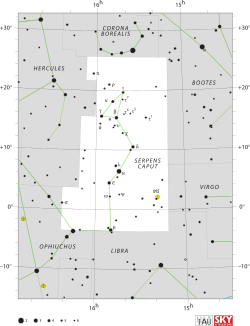Lambda Serpentis

| |
| Observation data Epoch J2000 Equinox J2000 | |
|---|---|
| Constellation | Serpens |
| Right ascension | 15h 46m 26.614s[1] |
| Declination | +07° 21′ 11.04″[1] |
| Apparent magnitude (V) | 4.43[2] |
| Characteristics | |
| Spectral type | G0 V[3] |
| U−B color index | +0.11[2] |
| B−V color index | +0.60[2] |
| Variable type | Suspected |
| Astrometry | |
| Radial velocity (Rv) | −66.4[4] km/s |
| Proper motion (μ) | RA: -224.00 ± 0.29[1] mas/yr Dec.: -70.64 ± 0.27[1] mas/yr |
| Parallax (π) | 82.48 ± 0.32[1] mas |
| Distance | 39.5 ± 0.2 ly (12.12 ± 0.05 pc) |
| Absolute magnitude (MV) | 4.07 |
| Details | |
| Mass | 1.14[5] M☉ |
| Radius | 1.060 ± 0.152[6] R☉ |
| Luminosity | 1.94[5] L☉ |
| Surface gravity (log g) | 4.09[7] cgs |
| Temperature | 5,884 ± 4.4[8] K |
| Metallicity [Fe/H] | −0.03[7] dex |
| Rotational velocity (v sin i) | 3[9] km/s |
| Age | 3.8–6.7[10] Gyr |
| Other designations | |
Lambda Serpentis (λ Ser, λ Serpentis) is a star in the constellation Serpens, in its head (Serpens Caput). It has an apparent visual magnitude of 4.43,[2] making it visible to the naked eye. Based upon parallax measurements from the Hipparcos satellite, this star lies at a distance of about 39.5 light-years (12.1 parsecs) from Earth.[1] This star is larger and more massive than the Sun, although it has a similar stellar classification.[3] It is shining with nearly double the Sun's luminosity and this energy is being radiated from the star's outer atmosphere at an effective temperature of 5,884 K.[8]
Lambda Serpentis is moving toward the Solar System with a radial velocity of 66.4 km s−1.[4] In about 166,000 years, this system will make its closest approach of the Sun at a distance of 7.371 ± 0.258 light-years (2.260 ± 0.079 parsecs), before moving away thereafter.[11]
A periodicity of 1837 days (5.03 years) was suspected by Morbey & Griffith (1987),[12] but it is probably bound to stellar activity. However, McDonald Observatory team has set limits to the presence of one or more planets[12] around Lambda Serpentis with masses between 0.16 and 2 Jupiter masses and average separations spanning between 0.05 and 5.2 Astronomical Units.
See also
References
- 1 2 3 4 5 6 van Leeuwen, F. (2007). "Validation of the new Hipparcos reduction". Astronomy and Astrophysics. 474 (2): 653–664. arXiv:0708.1752
 . Bibcode:2007A&A...474..653V. doi:10.1051/0004-6361:20078357. Vizier catalog entry
. Bibcode:2007A&A...474..653V. doi:10.1051/0004-6361:20078357. Vizier catalog entry - 1 2 3 4 Johnson, H. L.; Morgan, W. W. (1953). "Fundamental stellar photometry for standards of spectral type on the revised system of the Yerkes spectral atlas". Astrophysical Journal. 117: 313–352. Bibcode:1953ApJ...117..313J. doi:10.1086/145697.
- 1 2 3 "lam Ser -- Spectroscopic binary". SIMBAD. Centre de Données astronomiques de Strasbourg. Retrieved 2010-12-15.
- 1 2 Wilson, Ralph Elmer (1953). General Catalogue of Stellar Radial Velocities. Washington: Carnegie Institution of Washington. Bibcode:1953GCRV..C......0W.
- 1 2 Valenti, J. A.; Fishcer, D. A. (2005). "Spectroscopic Properties of Cool Stars (SPOCS). I. 1040 F, G, and K Dwarfs from Keck, Lick, and AAT Planet Search Programs". Astrophysical Journal Supplement Series. 159 (1): 141–166. Bibcode:2005ApJS..159..141V. doi:10.1086/430500.
- ↑ van Belle, Gerard T.; von Braun, Kaspar (2009). "Directly Determined Linear Radii and Effective Temperatures of Exoplanet Host Stars". The Astrophysical Journal. 694 (2): 1085–1098. arXiv:0901.1206
 . Bibcode:2009ApJ...694.1085V. doi:10.1088/0004-637X/694/2/1085.
. Bibcode:2009ApJ...694.1085V. doi:10.1088/0004-637X/694/2/1085. - 1 2 Fuhrmann, Klaus (October 1998). "Nearby stars of the Galactic disk and halo". Astronomy and Astrophysics. 338: 161–183. Bibcode:1998A&A...338..161F.
- 1 2 Kovtyukh; Soubiran, C.; Belik, S. I.; Gorlova, N. I. (2003). "High precision effective temperatures for 181 F-K dwarfs from line-depth ratios". Astronomy and Astrophysics. 411 (3): 559–564. arXiv:astro-ph/0308429
 . Bibcode:2003A&A...411..559K. doi:10.1051/0004-6361:20031378.
. Bibcode:2003A&A...411..559K. doi:10.1051/0004-6361:20031378. - ↑ Bernacca, P. L.; Perinotto, M. (1970). "A catalogue of stellar rotational velocities". Contributi Osservatorio Astronomico di Padova in Asiago. 239 (1). Bibcode:1970CoAsi.239....1B.
- ↑ Mamajek, Eric E.; Hillenbrand, Lynne A. (November 2008). "Improved Age Estimation for Solar-Type Dwarfs Using Activity-Rotation Diagnostics". The Astrophysical Journal. 687 (2): 1264–1293. arXiv:0807.1686
 . Bibcode:2008ApJ...687.1264M. doi:10.1086/591785.
. Bibcode:2008ApJ...687.1264M. doi:10.1086/591785. - ↑ Dybczyński, P. A. (April 2006), "Simulating observable comets. III. Real stellar perturbers of the Oort cloud and their output", Astronomy and Astrophysics, 449 (3): 1233–1242, Bibcode:2006A&A...449.1233D, doi:10.1051/0004-6361:20054284
- 1 2 Morbey, C. L.; Griffith, R. F. (1987). "On the reality of certain spectroscopic orbits". Astrophysical Journal. 317 (1): 343–352. Bibcode:1987ApJ...317..343M. doi:10.1086/165281.
Further reading
- Wittenmeyer, R. A.; et al. (2006). "Detection Limits from the McDonald Observatory Planet Search Program". Astronomical Journal. 132 (1): 177–188. arXiv:astro-ph/0604171
 . Bibcode:2006AJ....132..177W. doi:10.1086/504942.
. Bibcode:2006AJ....132..177W. doi:10.1086/504942.